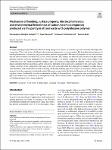Item Infomation
Full metadata record
| DC Field | Value | Language |
|---|---|---|
| dc.contributor.author | Orevaoghene Eterigho-Ikelegbe, Orevaoghene | - |
| dc.contributor.author | Trammell, Ryan | - |
| dc.contributor.author | Ricohermoso III, Emmanuel | - |
| dc.date.accessioned | 2023-08-14T03:16:50Z | - |
| dc.date.available | 2023-08-14T03:16:50Z | - |
| dc.date.issued | 2023 | - |
| dc.identifier.uri | https://link.springer.com/article/10.1007/s11356-023-28661-z | - |
| dc.identifier.uri | https://dlib.phenikaa-uni.edu.vn/handle/PNK/8792 | - |
| dc.description | CC-BY | vi |
| dc.description.abstract | A simple mixing-pressing followed by thermal curing and pyrolysis process was used to upcycle coal waste into high-value composites. Three coal wastes of different physicochemical properties were investigated. The hypothetical mechanisms of bonding between the coal particles and the preceramic polymer are presented. The textural properties of the coals indicated that the lowest volatile coal waste (PCD) had a dense structure. This limited the diffusion and reaction of the preceramic polymer with the coal waste during pyrolysis, thereby leading to low-quality composites. The water contact angles of the composites up to 104° imply hydrophobic surfaces, hence, no external coating might be required. Analysis of the carbon phase confirmed that the amorphous carbon structure is prevalent in the composites compared to the coal wastes. | vi |
| dc.language.iso | en | vi |
| dc.publisher | Springer | vi |
| dc.subject | PCD | vi |
| dc.subject | simple mixing-pressing | vi |
| dc.title | Mechanism of bonding, surface property, electrical behaviour, and environmental friendliness of carbon/ceramic composites produced via the pyrolysis of coal waste with polysiloxane polymer | vi |
| dc.type | Book | vi |
| Appears in Collections | ||
| OER - Khoa học môi trường | ||
Files in This Item:

